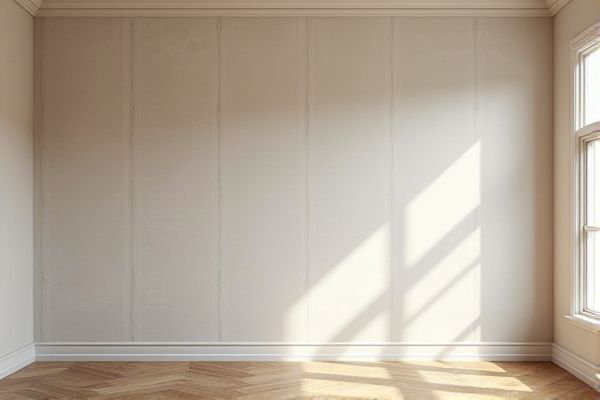
Drywall offers a smooth, paint-ready surface ideal for a modern, clean look, while wall paneling provides texture and decorative appeal with options like wood or vinyl. Explore the rest of the article to discover which option best suits your design preferences and functional needs.
Table of Comparison
| Feature | Drywall | Wall Paneling |
|---|---|---|
| Material | Gypsum plasterboard sheets | Wood, MDF, PVC, or composite panels |
| Installation | Requires taping, mudding, sanding, and painting | Quick installation with adhesive or nails |
| Durability | Moderate; prone to dents and water damage | High; resistant to impacts and moisture (varies by material) |
| Maintenance | Requires repainting and patching | Easy to clean and maintain |
| Cost | Low to moderate | Moderate to high depending on material |
| Design & Aesthetics | Smooth, versatile surface for paint or wallpaper | Textured, decorative, adds warmth and style |
| Insulation | Minimal inherent insulation | Can offer additional insulation properties |
| Soundproofing | Limited soundproofing unless layered | Better sound absorption if thick or layered |
Introduction to Drywall and Wall Paneling
Drywall, composed primarily of gypsum plaster pressed between two thick sheets of paper, is widely used for interior walls and ceilings due to its smooth finish and ease of installation. Wall paneling, often made from wood, MDF, or PVC, offers textured or decorative surfaces that add aesthetic depth and durability to walls. Both materials serve distinct functional and stylistic purposes in interior construction and design.
Key Differences Between Drywall and Wall Paneling
Drywall consists of gypsum plaster sandwiched between two thick sheets of paper, offering a smooth, paint-ready surface ideal for customization, while wall paneling typically features wood, MDF, or PVC materials that add texture and visual interest. Drywall provides superior fire resistance and soundproofing capabilities, whereas wall paneling excels in durability and moisture resistance, making it suitable for areas prone to humidity. Understanding these key differences helps you choose the best option based on your space's aesthetic preferences and functional needs.
Material Composition and Types
Drywall is primarily composed of gypsum plaster pressed between two thick sheets of paper, available in standard, moisture-resistant, and fire-resistant types suited for various applications. Wall paneling includes materials like wood, MDF, PVC, or metal, offering options such as beadboard, shiplap, or textured panels that enhance aesthetic appeal and durability. Choosing between drywall and wall paneling depends on your preference for material properties, installation ease, and desired finish.
Installation Process and Ease
Drywall installation involves measuring, cutting gypsum boards, securing them to wall studs, and applying multiple coats of joint compound for a smooth finish. Wall paneling typically requires attaching pre-finished panels directly to the studs or existing walls, often reducing labor time and eliminating the need for taping or sanding. Drywall demands more skill and drying time, whereas wall paneling offers a quicker, less messy installation suitable for DIY projects.
Durability and Longevity Comparison
Drywall offers moderate durability, being prone to dents and moisture damage, requiring regular maintenance to ensure longevity. Wall paneling, especially wood or high-density fiberboard varieties, provides superior resistance to impact and moisture, resulting in a longer lifespan with less upkeep. Choosing wall paneling enhances durability in high-traffic areas, while drywall is more cost-effective but demands frequent repairs to maintain structural integrity.
Aesthetic Options and Design Flexibility
Drywall offers a smooth, versatile surface that can be painted, textured, or wallpapered to match any aesthetic, providing broad design flexibility for customizing your walls. Wall paneling, available in materials like wood, MDF, or PVC, introduces rich textures and patterns that add depth and character, often creating a more distinct and decorative look. Choosing between drywall and wall paneling depends on your design goals, whether you prefer a sleek, modern finish or a warm, dimensional appearance for your space.
Cost Analysis: Drywall vs. Wall Paneling
Drywall installation typically costs between $1.50 and $3.50 per square foot, offering an affordable solution with a smooth, paint-ready surface. Wall paneling prices range from $3 to $10 per square foot, depending on material choices like wood, MDF, or PVC, often increasing overall project expenditure. Maintenance and durability vary, with drywall requiring occasional repairs, while higher-end paneling can add value and longevity, influencing long-term cost-effectiveness.
Maintenance and Repair Considerations
Drywall requires patching and sanding to repair dents or holes, often needing repainting to restore appearance, whereas wall paneling allows easier replacement of damaged sections without extensive surface prep. Moisture-resistant panels offer advantages in maintenance over drywall in damp areas, reducing mold and mildew risks. Regular cleaning for paneling involves wiping with mild cleaners, contrasting with drywall's susceptibility to staining and water damage that complicates upkeep.
Insulation and Soundproofing Properties
Drywall typically offers better soundproofing due to its density and ability to be combined with insulation materials like fiberglass or foam within wall cavities. Wall paneling, often made from wood or plastic, provides limited insulation and soundproofing, making it less effective at reducing noise transmission. For improved thermal and acoustic insulation, drywall paired with specialized insulation products remains the preferred choice in construction and remodeling projects.
Which is Right for Your Space?
Drywall offers a smooth, paint-ready surface ideal for creating a modern, seamless look, making it perfect for those seeking versatility in design and easy customization. Wall paneling, available in wood, MDF, or PVC, provides texture and architectural interest, enhancing spaces with warmth and character, especially in traditional or rustic interiors. The choice depends on your desired aesthetic, budget, and maintenance preference, with drywall being cost-effective and simple to repair, while paneling offers durability and unique visual appeal.
 homyna.com
homyna.com